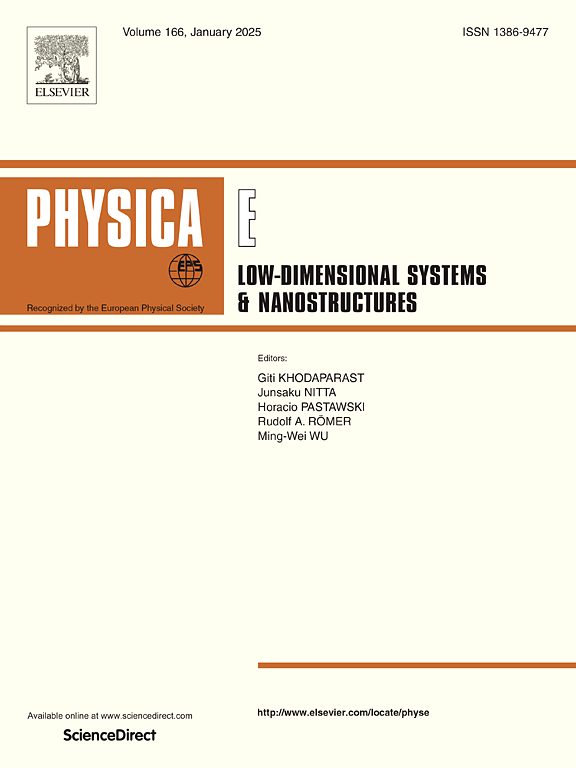Valley-dependent electronic transport in a graphene with double magnetic-strained barriers
IF 2.9
3区 物理与天体物理
Q3 NANOSCIENCE & NANOTECHNOLOGY
Physica E-low-dimensional Systems & Nanostructures
Pub Date : 2025-01-06
DOI:10.1016/j.physe.2025.116176
引用次数: 0
Abstract
Using the transfer-matrix method, we investigate the valley-dependent electronic transport in a graphene with double magnetic-strained barriers. The effects of the magnitude, position and width of the strained barriers as well as the strength of the magnetic field on the electronic conductance and the valley polarization in the parallel (P) configuration are analyzed. In order to comprehensively understand and apply this model, we also study how the strength of the magnetic field and the magnitude of the strained barriers affect the valley polarization when the ferromagnetic metal (FM) stripes are shifted from P configuration to antiparallel (AP) configuration. The results show that the magnetic field and the strains significantly influence the electronic transport properties in both P and AP configurations. Therefore, this work provides crucial help for understanding valley-dependent transport characteristics, and the studied graphene nanostructure is useful for designing the valleytronic device.
具有双磁应变势垒的石墨烯中谷相关的电子输运
利用传递矩阵方法,我们研究了具有双磁应变势垒的石墨烯中与谷相关的电子输运。分析了应变势垒的大小、位置和宽度以及磁场强度对平行(P)结构中电子电导和谷极化的影响。为了全面理解和应用该模型,我们还研究了当铁磁金属(FM)条纹从P位向反平行(AP)位转变时,磁场强度和应变势垒大小对谷极化的影响。结果表明,磁场和应变对P和AP两种构型的电子输运性质都有显著影响。因此,这项工作为理解谷相关输运特性提供了至关重要的帮助,所研究的石墨烯纳米结构对设计谷电子器件是有用的。
本文章由计算机程序翻译,如有差异,请以英文原文为准。
求助全文
约1分钟内获得全文
求助全文
来源期刊
CiteScore
7.30
自引率
6.10%
发文量
356
审稿时长
65 days
期刊介绍:
Physica E: Low-dimensional systems and nanostructures contains papers and invited review articles on the fundamental and applied aspects of physics in low-dimensional electron systems, in semiconductor heterostructures, oxide interfaces, quantum wells and superlattices, quantum wires and dots, novel quantum states of matter such as topological insulators, and Weyl semimetals.
Both theoretical and experimental contributions are invited. Topics suitable for publication in this journal include spin related phenomena, optical and transport properties, many-body effects, integer and fractional quantum Hall effects, quantum spin Hall effect, single electron effects and devices, Majorana fermions, and other novel phenomena.
Keywords:
• topological insulators/superconductors, majorana fermions, Wyel semimetals;
• quantum and neuromorphic computing/quantum information physics and devices based on low dimensional systems;
• layered superconductivity, low dimensional systems with superconducting proximity effect;
• 2D materials such as transition metal dichalcogenides;
• oxide heterostructures including ZnO, SrTiO3 etc;
• carbon nanostructures (graphene, carbon nanotubes, diamond NV center, etc.)
• quantum wells and superlattices;
• quantum Hall effect, quantum spin Hall effect, quantum anomalous Hall effect;
• optical- and phonons-related phenomena;
• magnetic-semiconductor structures;
• charge/spin-, magnon-, skyrmion-, Cooper pair- and majorana fermion- transport and tunneling;
• ultra-fast nonlinear optical phenomena;
• novel devices and applications (such as high performance sensor, solar cell, etc);
• novel growth and fabrication techniques for nanostructures

 求助内容:
求助内容: 应助结果提醒方式:
应助结果提醒方式:


